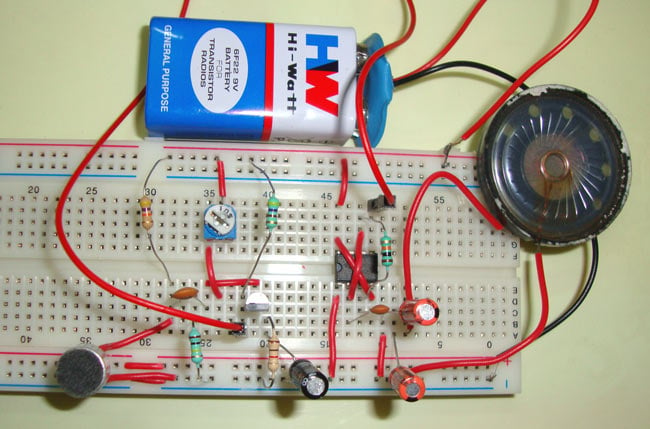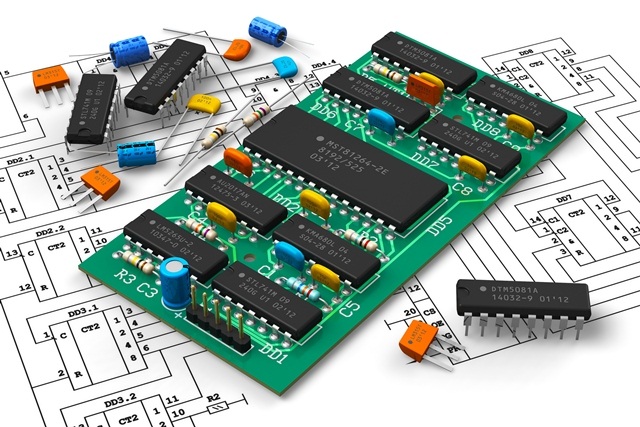If you’re a novice in electronics or just starting to build your electrical circuits, it is vital that you familiarize with all the essential electronic components used in circuits. Without a proper understanding of the fundamental electronic components and aspects such as their purpose, ratings, values, etc. the chances are that your circuit design will not function as it should. In most circuits, the components used in building the circuit are categorized into active components and passive components. Active components are basically components which control and supply energy whereas passive components are those that respond to the electrical energy flow and can store or dissipate heat. This article provides some insight into the various electronic components used in building circuits.
Resistor
This is an electronic component that restricts current flow in a circuit. Additionally, a resistor could be used to afford a specified voltage rating to a transistor. When there is current flowing through a resistor, the resistor will absorb all the electrical energy and degenerate it as heat. Resistors could have variable or fixed resistance values, which could be found in photoresistors, thermistors, trimmers, potentiometers, hamsters, and varistors. Current flowing through the resistor is always proportional to the voltage that is across the terminals of the resistor, a relationship defined by Ohm’s law.

Capacitors
Capacitors are basically two-terminal passive electronic components having two conductive plates that have a dielectric medium or insulator in between them. A capacitor’s primary use is to store electrical energy once electrical charges are forced onto the capacitor terminals from a power source. A capacitor will maintain this charge even when it is disconnected from the supplying power source. In timing circuits, capacitors could be used with resistors in addition to being used as a filter to block DC signals and permit the flow of AC signals.
Microcontroller
This is usually a small computer that is mounted on a single integrated circuit, and that incorporates all features present in a microprocessor. For it to serve numerous purposes and applications, a microcontroller is loaded with multiple chip amenities like ROM, RAM, I/O ports, timers, a clock circuit, interrupt circuit, and a serial port. Microcontrollers are often used in various automatically controlled gadgets like medical devices, remote controls, power tools, vehicle engine control systems, office machines, and toys among many other embedded systems. A microcontroller must be programmed so that it can execute different instructions and commands.
Inductor
Inductors, or coils, or reactors are basically two-terminal passive electronic components whose primary function is to store electrical energy in the form of magnetic energy. In most cases, an inductor will comprise a conductor, which is often wound into a coil, which works based on Faraday’s law of inductance. When an electric current flows from one side of the loop to the other (say left to right), the coil will produce a magnetic field in the clockwise direction. The inductance of inductors is often denoted by ‘L.’
Transformer
This is another fundamental electronic component consisting of two coils of wire, both of which are linked by an iron core. A transformer provides the ability to change the voltage and current levels easily. Its primary function, however, is to decrease (step-down) or increase (step-up) AC voltages in an electric circuit and works based on Faraday’s law of electromagnetic induction. A transformer converts electrical energy coming from one circuit to another circuit through mutual induction between the windings without the need for an electrical connection between. Besides, a transformer can also convert power from a single circuit to another circuit without causing a frequency change but with different voltage levels.
A step-up transformer has more windings on the secondary coil than on the primary coil whereas step-down transformers have more windings in the primary coil.
Battery
This is an electrical gadget that is used in the conversion of chemical energy into electrical energy through electrochemical reactions. Batteries are usually composed of a single or multiple cells, with each cell having a cathode (negative terminal), an anode (positive terminal), and an electrolyte. Batteries are usually categorized into two, i.e., disposable or primary batteries and rechargeable or secondary batteries.
Transistors
Transistors are usually electronic devices that have three terminals which are made of semiconductor materials that are meant to control the flow of current or voltage as well as function as switches for electronic signals. The two common types of transistors are NPN and PNP with most circuits using the former. Transistors come in different shapes hence the three transistor terminals (collector, emitter, and base) do not have a fixed configuration. In applications where the base terminal is required to activate the transistor, the collector terminal is positive while the emitter terminal is negative.
Relays
These are mainly electromechanical switches often used to control circuits with the aid of low power signals. Relays were initially used as amplifiers in most long distance telegraph circuits. The two circuits in a relay have no electrical connection since they are connected magnetically. Relays could also be used to execute logical operations in computers and telephone exchanges.
Diode
This is an electronic device that is made from semiconductor materials and which allows the flow of current in one direction while blocking its flow in the opposite direction. This means that current in a diode or light emitting diode will always flow in one direction, hence there is no return path. Diodes are mostly used in electronic circuits that require the conversion of AC to DC. A light emitting diode could be an alternative to a diode. When current is applied to a light emitting diode, light is emitted at a specific frequency. Light emitting diodes are often used in many applications such as hard disks, keyboards, TV remote controls, and other devices that are used as status indicators in electric appliances.
The list of essential electronic components price list used in implementing various circuits and projects is literally endless. However, the above components are just a few of what you should familiarize with if you are looking to build an electric circuit








+ There are no comments
Add yours